Robotics in Sustainable Agriculture & Horticulture: Farm Note
VerifiedAdded on 2023/06/11
|7
|1895
|95
Report
AI Summary
This report provides a comprehensive analysis of the application of robotics in sustainable agriculture and horticulture, particularly in developing countries. It begins by introducing sustainable agricultural practices and their goals, emphasizing the reduction of harmful chemicals and the protection of biodiversity. The report then delves into the global, national, and farm-level implications of using robotics, such as addressing soil compaction and herbicide resistance. The Triple Bottom Line (TBL) framework is used to assess the environmental, social, and economic impacts of these technologies, highlighting benefits like reduced labor shortages and decreased environmental impact. Furthermore, the report discusses risk management strategies, including the use of collaborative robots to balance automation with necessary human intervention. It concludes by underscoring the importance of integrating robotics with careful monitoring to achieve a more sustainable future in agriculture, addressing critical concerns like water pollution and pesticide overuse.
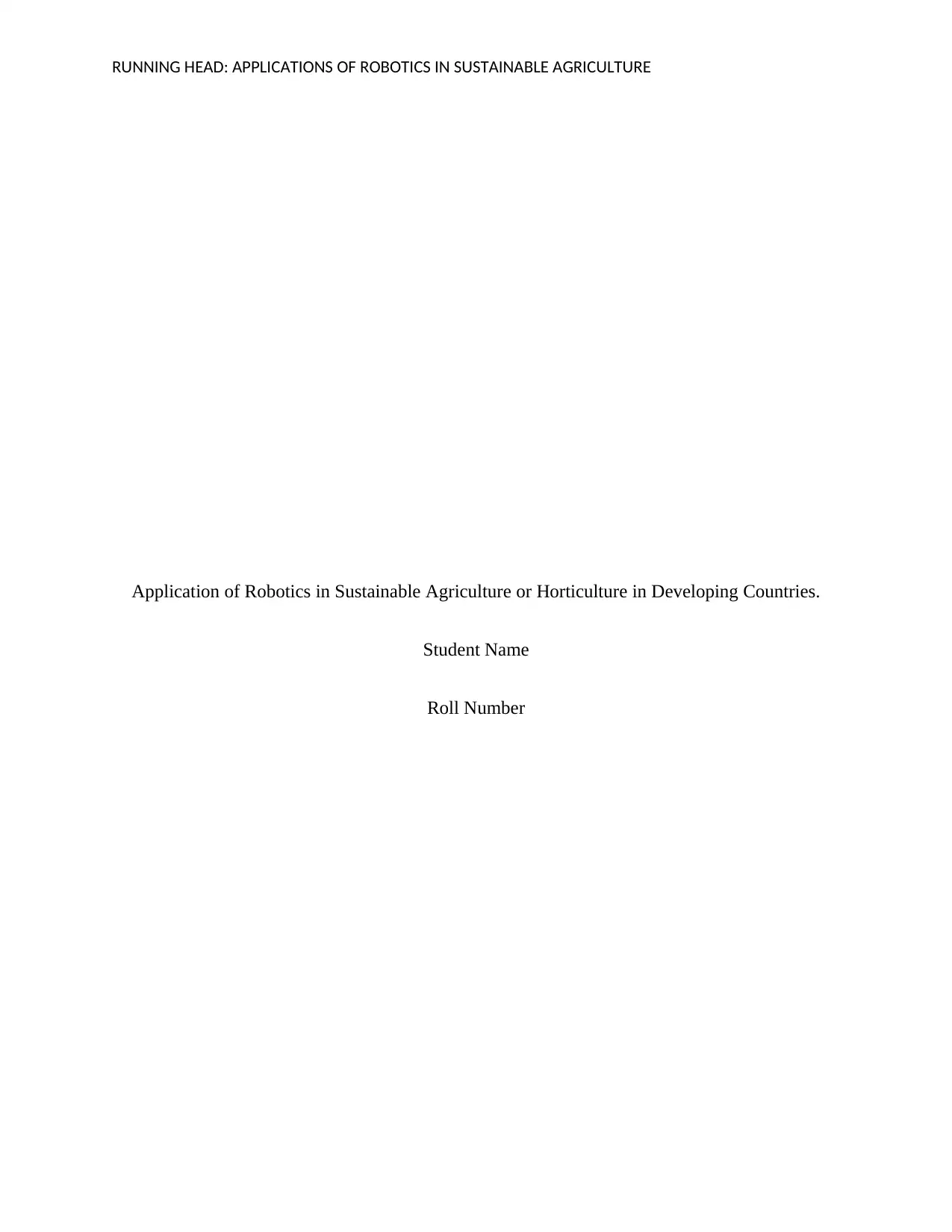
RUNNING HEAD: APPLICATIONS OF ROBOTICS IN SUSTAINABLE AGRICULTURE
Application of Robotics in Sustainable Agriculture or Horticulture in Developing Countries.
Student Name
Roll Number
Application of Robotics in Sustainable Agriculture or Horticulture in Developing Countries.
Student Name
Roll Number
Paraphrase This Document
Need a fresh take? Get an instant paraphrase of this document with our AI Paraphraser
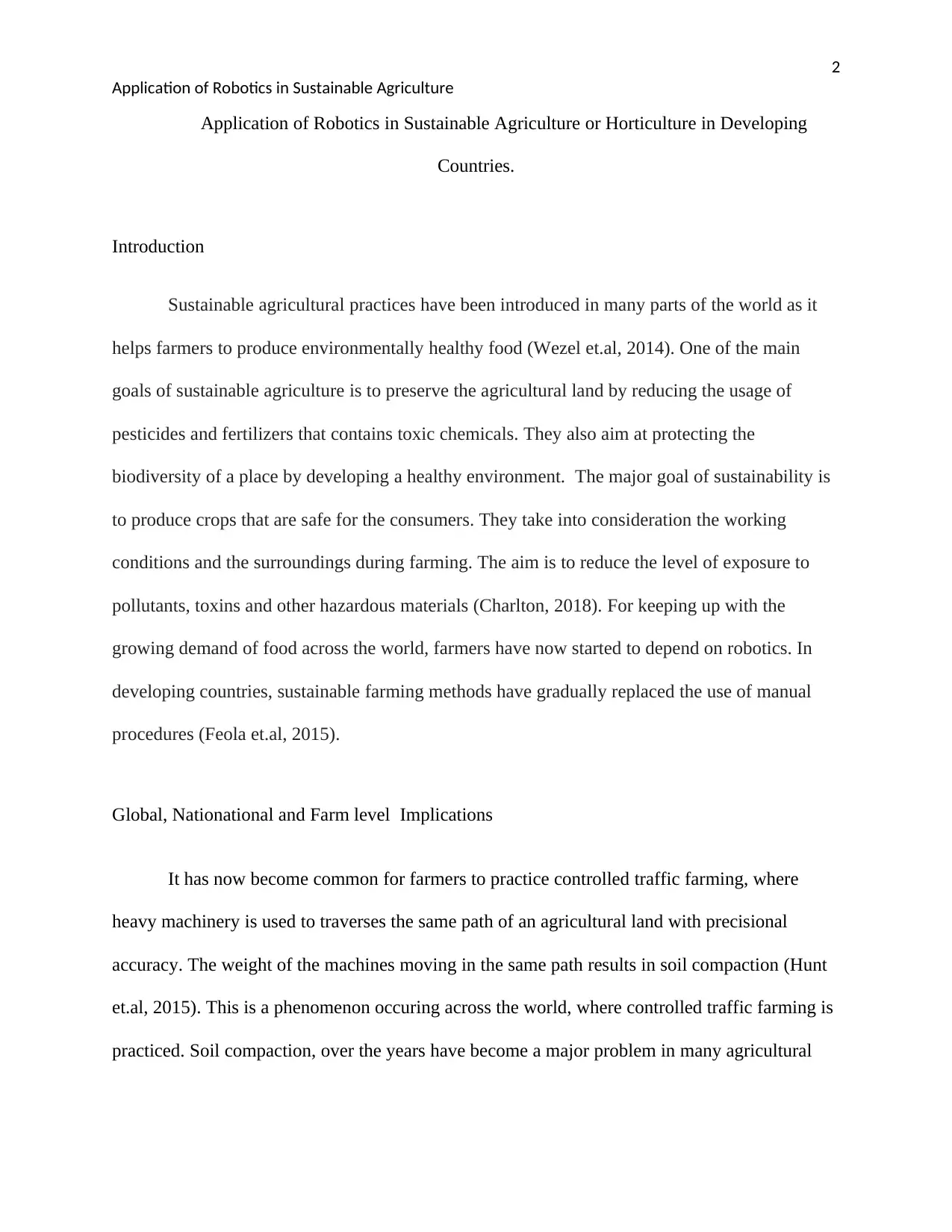
2
Application of Robotics in Sustainable Agriculture
Application of Robotics in Sustainable Agriculture or Horticulture in Developing
Countries.
Introduction
Sustainable agricultural practices have been introduced in many parts of the world as it
helps farmers to produce environmentally healthy food (Wezel et.al, 2014). One of the main
goals of sustainable agriculture is to preserve the agricultural land by reducing the usage of
pesticides and fertilizers that contains toxic chemicals. They also aim at protecting the
biodiversity of a place by developing a healthy environment. The major goal of sustainability is
to produce crops that are safe for the consumers. They take into consideration the working
conditions and the surroundings during farming. The aim is to reduce the level of exposure to
pollutants, toxins and other hazardous materials (Charlton, 2018). For keeping up with the
growing demand of food across the world, farmers have now started to depend on robotics. In
developing countries, sustainable farming methods have gradually replaced the use of manual
procedures (Feola et.al, 2015).
Global, Nationational and Farm level Implications
It has now become common for farmers to practice controlled traffic farming, where
heavy machinery is used to traverses the same path of an agricultural land with precisional
accuracy. The weight of the machines moving in the same path results in soil compaction (Hunt
et.al, 2015). This is a phenomenon occuring across the world, where controlled traffic farming is
practiced. Soil compaction, over the years have become a major problem in many agricultural
Application of Robotics in Sustainable Agriculture
Application of Robotics in Sustainable Agriculture or Horticulture in Developing
Countries.
Introduction
Sustainable agricultural practices have been introduced in many parts of the world as it
helps farmers to produce environmentally healthy food (Wezel et.al, 2014). One of the main
goals of sustainable agriculture is to preserve the agricultural land by reducing the usage of
pesticides and fertilizers that contains toxic chemicals. They also aim at protecting the
biodiversity of a place by developing a healthy environment. The major goal of sustainability is
to produce crops that are safe for the consumers. They take into consideration the working
conditions and the surroundings during farming. The aim is to reduce the level of exposure to
pollutants, toxins and other hazardous materials (Charlton, 2018). For keeping up with the
growing demand of food across the world, farmers have now started to depend on robotics. In
developing countries, sustainable farming methods have gradually replaced the use of manual
procedures (Feola et.al, 2015).
Global, Nationational and Farm level Implications
It has now become common for farmers to practice controlled traffic farming, where
heavy machinery is used to traverses the same path of an agricultural land with precisional
accuracy. The weight of the machines moving in the same path results in soil compaction (Hunt
et.al, 2015). This is a phenomenon occuring across the world, where controlled traffic farming is
practiced. Soil compaction, over the years have become a major problem in many agricultural
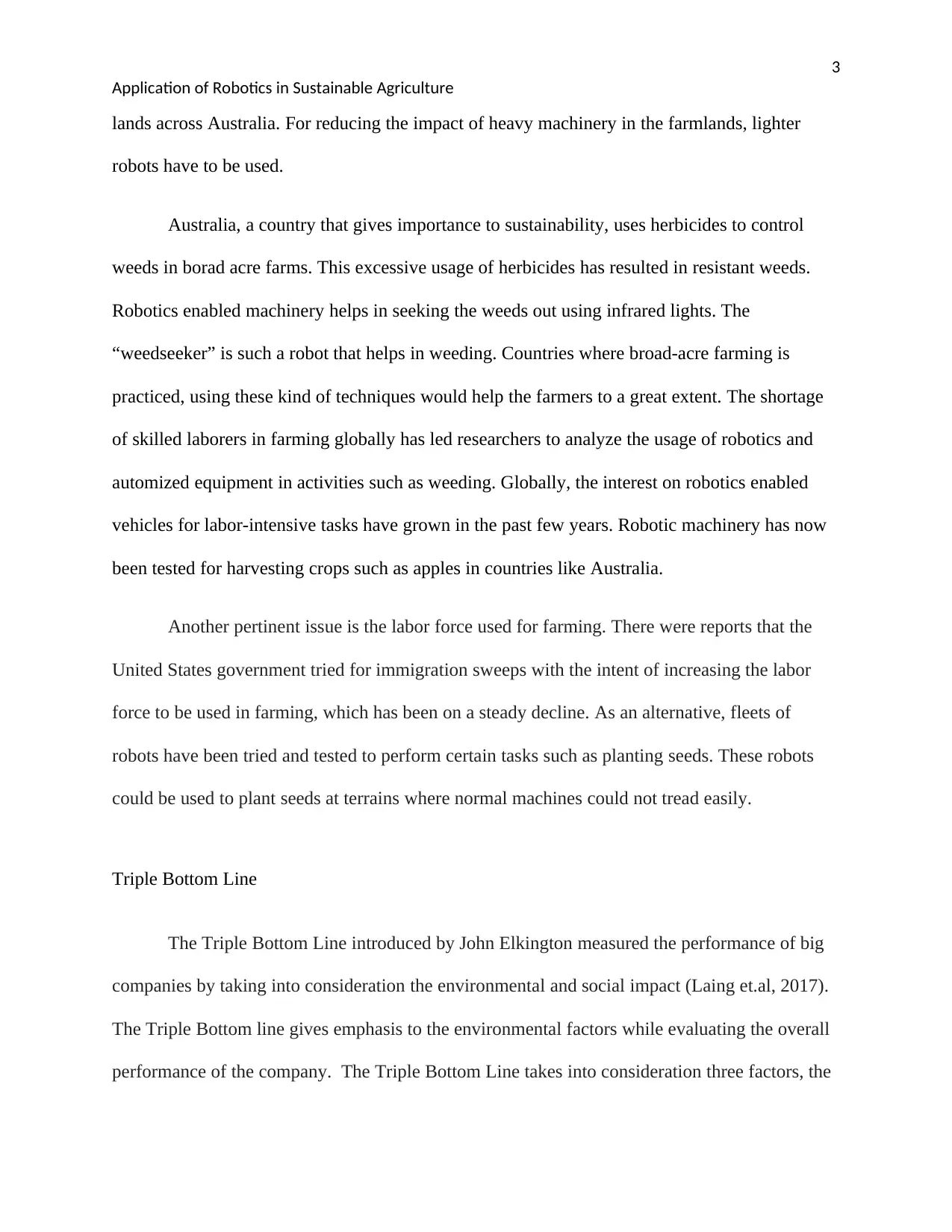
3
Application of Robotics in Sustainable Agriculture
lands across Australia. For reducing the impact of heavy machinery in the farmlands, lighter
robots have to be used.
Australia, a country that gives importance to sustainability, uses herbicides to control
weeds in borad acre farms. This excessive usage of herbicides has resulted in resistant weeds.
Robotics enabled machinery helps in seeking the weeds out using infrared lights. The
“weedseeker” is such a robot that helps in weeding. Countries where broad-acre farming is
practiced, using these kind of techniques would help the farmers to a great extent. The shortage
of skilled laborers in farming globally has led researchers to analyze the usage of robotics and
automized equipment in activities such as weeding. Globally, the interest on robotics enabled
vehicles for labor-intensive tasks have grown in the past few years. Robotic machinery has now
been tested for harvesting crops such as apples in countries like Australia.
Another pertinent issue is the labor force used for farming. There were reports that the
United States government tried for immigration sweeps with the intent of increasing the labor
force to be used in farming, which has been on a steady decline. As an alternative, fleets of
robots have been tried and tested to perform certain tasks such as planting seeds. These robots
could be used to plant seeds at terrains where normal machines could not tread easily.
Triple Bottom Line
The Triple Bottom Line introduced by John Elkington measured the performance of big
companies by taking into consideration the environmental and social impact (Laing et.al, 2017).
The Triple Bottom line gives emphasis to the environmental factors while evaluating the overall
performance of the company. The Triple Bottom Line takes into consideration three factors, the
Application of Robotics in Sustainable Agriculture
lands across Australia. For reducing the impact of heavy machinery in the farmlands, lighter
robots have to be used.
Australia, a country that gives importance to sustainability, uses herbicides to control
weeds in borad acre farms. This excessive usage of herbicides has resulted in resistant weeds.
Robotics enabled machinery helps in seeking the weeds out using infrared lights. The
“weedseeker” is such a robot that helps in weeding. Countries where broad-acre farming is
practiced, using these kind of techniques would help the farmers to a great extent. The shortage
of skilled laborers in farming globally has led researchers to analyze the usage of robotics and
automized equipment in activities such as weeding. Globally, the interest on robotics enabled
vehicles for labor-intensive tasks have grown in the past few years. Robotic machinery has now
been tested for harvesting crops such as apples in countries like Australia.
Another pertinent issue is the labor force used for farming. There were reports that the
United States government tried for immigration sweeps with the intent of increasing the labor
force to be used in farming, which has been on a steady decline. As an alternative, fleets of
robots have been tried and tested to perform certain tasks such as planting seeds. These robots
could be used to plant seeds at terrains where normal machines could not tread easily.
Triple Bottom Line
The Triple Bottom Line introduced by John Elkington measured the performance of big
companies by taking into consideration the environmental and social impact (Laing et.al, 2017).
The Triple Bottom line gives emphasis to the environmental factors while evaluating the overall
performance of the company. The Triple Bottom Line takes into consideration three factors, the
⊘ This is a preview!⊘
Do you want full access?
Subscribe today to unlock all pages.

Trusted by 1+ million students worldwide
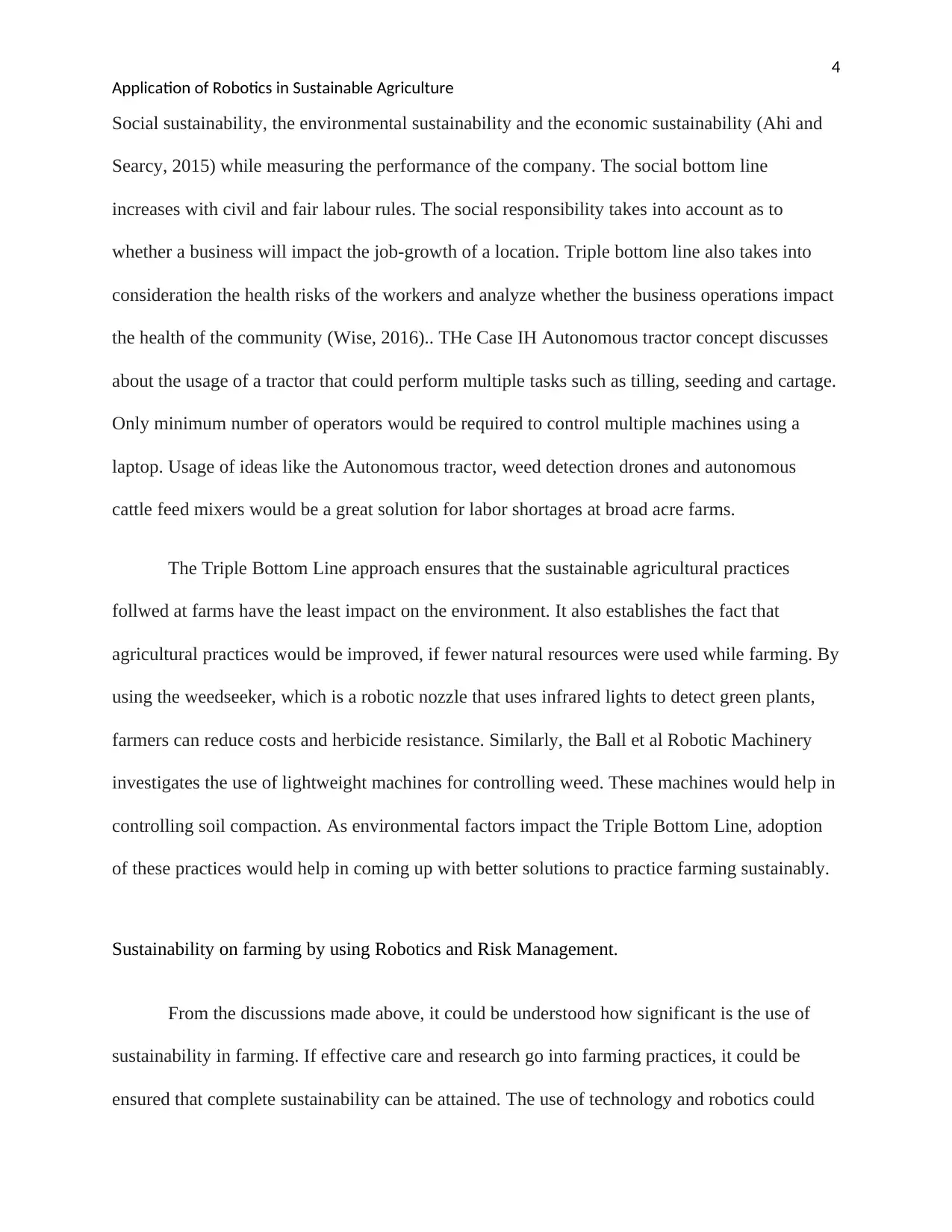
4
Application of Robotics in Sustainable Agriculture
Social sustainability, the environmental sustainability and the economic sustainability (Ahi and
Searcy, 2015) while measuring the performance of the company. The social bottom line
increases with civil and fair labour rules. The social responsibility takes into account as to
whether a business will impact the job-growth of a location. Triple bottom line also takes into
consideration the health risks of the workers and analyze whether the business operations impact
the health of the community (Wise, 2016).. THe Case IH Autonomous tractor concept discusses
about the usage of a tractor that could perform multiple tasks such as tilling, seeding and cartage.
Only minimum number of operators would be required to control multiple machines using a
laptop. Usage of ideas like the Autonomous tractor, weed detection drones and autonomous
cattle feed mixers would be a great solution for labor shortages at broad acre farms.
The Triple Bottom Line approach ensures that the sustainable agricultural practices
follwed at farms have the least impact on the environment. It also establishes the fact that
agricultural practices would be improved, if fewer natural resources were used while farming. By
using the weedseeker, which is a robotic nozzle that uses infrared lights to detect green plants,
farmers can reduce costs and herbicide resistance. Similarly, the Ball et al Robotic Machinery
investigates the use of lightweight machines for controlling weed. These machines would help in
controlling soil compaction. As environmental factors impact the Triple Bottom Line, adoption
of these practices would help in coming up with better solutions to practice farming sustainably.
Sustainability on farming by using Robotics and Risk Management.
From the discussions made above, it could be understood how significant is the use of
sustainability in farming. If effective care and research go into farming practices, it could be
ensured that complete sustainability can be attained. The use of technology and robotics could
Application of Robotics in Sustainable Agriculture
Social sustainability, the environmental sustainability and the economic sustainability (Ahi and
Searcy, 2015) while measuring the performance of the company. The social bottom line
increases with civil and fair labour rules. The social responsibility takes into account as to
whether a business will impact the job-growth of a location. Triple bottom line also takes into
consideration the health risks of the workers and analyze whether the business operations impact
the health of the community (Wise, 2016).. THe Case IH Autonomous tractor concept discusses
about the usage of a tractor that could perform multiple tasks such as tilling, seeding and cartage.
Only minimum number of operators would be required to control multiple machines using a
laptop. Usage of ideas like the Autonomous tractor, weed detection drones and autonomous
cattle feed mixers would be a great solution for labor shortages at broad acre farms.
The Triple Bottom Line approach ensures that the sustainable agricultural practices
follwed at farms have the least impact on the environment. It also establishes the fact that
agricultural practices would be improved, if fewer natural resources were used while farming. By
using the weedseeker, which is a robotic nozzle that uses infrared lights to detect green plants,
farmers can reduce costs and herbicide resistance. Similarly, the Ball et al Robotic Machinery
investigates the use of lightweight machines for controlling weed. These machines would help in
controlling soil compaction. As environmental factors impact the Triple Bottom Line, adoption
of these practices would help in coming up with better solutions to practice farming sustainably.
Sustainability on farming by using Robotics and Risk Management.
From the discussions made above, it could be understood how significant is the use of
sustainability in farming. If effective care and research go into farming practices, it could be
ensured that complete sustainability can be attained. The use of technology and robotics could
Paraphrase This Document
Need a fresh take? Get an instant paraphrase of this document with our AI Paraphraser

5
Application of Robotics in Sustainable Agriculture
also reduce the environmental impact of farming practices to a large extent. Especially in the
case of soil compaction, the lightweight robot enabled machinery could be considered as
excellent alternatives to address the issue of soil compaction. The more research goes into the
study of robotics enabled farming, the more it would help farmers and farming practices to
become sustainable. The Triple Bottom line could also be used to effectively to measure the role
of sustainability during farming. It could be used as a tool to measure the sustainability of the
produces that reaches the consumer (Bergerman et.al, 2016).
As discussed earlier, the main advantage of using Robotics in agriculture is that it reduces
human labor to a considerable degree. But the activities carried out by robots while farming may
not be devoid of risks. Farming is an activity that requires human intervention and supervision.
The major drawback of large-scale automization of this industry is that there may be certain
areas where human intervention may be necessary. There should be sufficient technology for
robots to identify certain things like a fruit’s degree of ripeness. Similarly, for precision farming,
better technology has to be introduced to identify the weeds. As simulations are carried out in
controlled environments, the question remains how these robots would fare in real conditions,
during harsh weather. It would always be challenging to train robots to identify their
surroundings better for protecting the crops. There is always the risk of unexpected damages or
injuries if robotics involve heavy machinery in farming.
As a risk management strategy, risk assessment tools could be used to identify the risks in
sustainable farming. In addition, as a protective measure, collaborative robots could be used to
perform the tasks. Collaborative robots could be used to carry out the operations in close
cooperation with a human. As farming activities require close supervision and human
intervention, both humans and robots could work simultaneously to achieve the desired results.
Application of Robotics in Sustainable Agriculture
also reduce the environmental impact of farming practices to a large extent. Especially in the
case of soil compaction, the lightweight robot enabled machinery could be considered as
excellent alternatives to address the issue of soil compaction. The more research goes into the
study of robotics enabled farming, the more it would help farmers and farming practices to
become sustainable. The Triple Bottom line could also be used to effectively to measure the role
of sustainability during farming. It could be used as a tool to measure the sustainability of the
produces that reaches the consumer (Bergerman et.al, 2016).
As discussed earlier, the main advantage of using Robotics in agriculture is that it reduces
human labor to a considerable degree. But the activities carried out by robots while farming may
not be devoid of risks. Farming is an activity that requires human intervention and supervision.
The major drawback of large-scale automization of this industry is that there may be certain
areas where human intervention may be necessary. There should be sufficient technology for
robots to identify certain things like a fruit’s degree of ripeness. Similarly, for precision farming,
better technology has to be introduced to identify the weeds. As simulations are carried out in
controlled environments, the question remains how these robots would fare in real conditions,
during harsh weather. It would always be challenging to train robots to identify their
surroundings better for protecting the crops. There is always the risk of unexpected damages or
injuries if robotics involve heavy machinery in farming.
As a risk management strategy, risk assessment tools could be used to identify the risks in
sustainable farming. In addition, as a protective measure, collaborative robots could be used to
perform the tasks. Collaborative robots could be used to carry out the operations in close
cooperation with a human. As farming activities require close supervision and human
intervention, both humans and robots could work simultaneously to achieve the desired results.
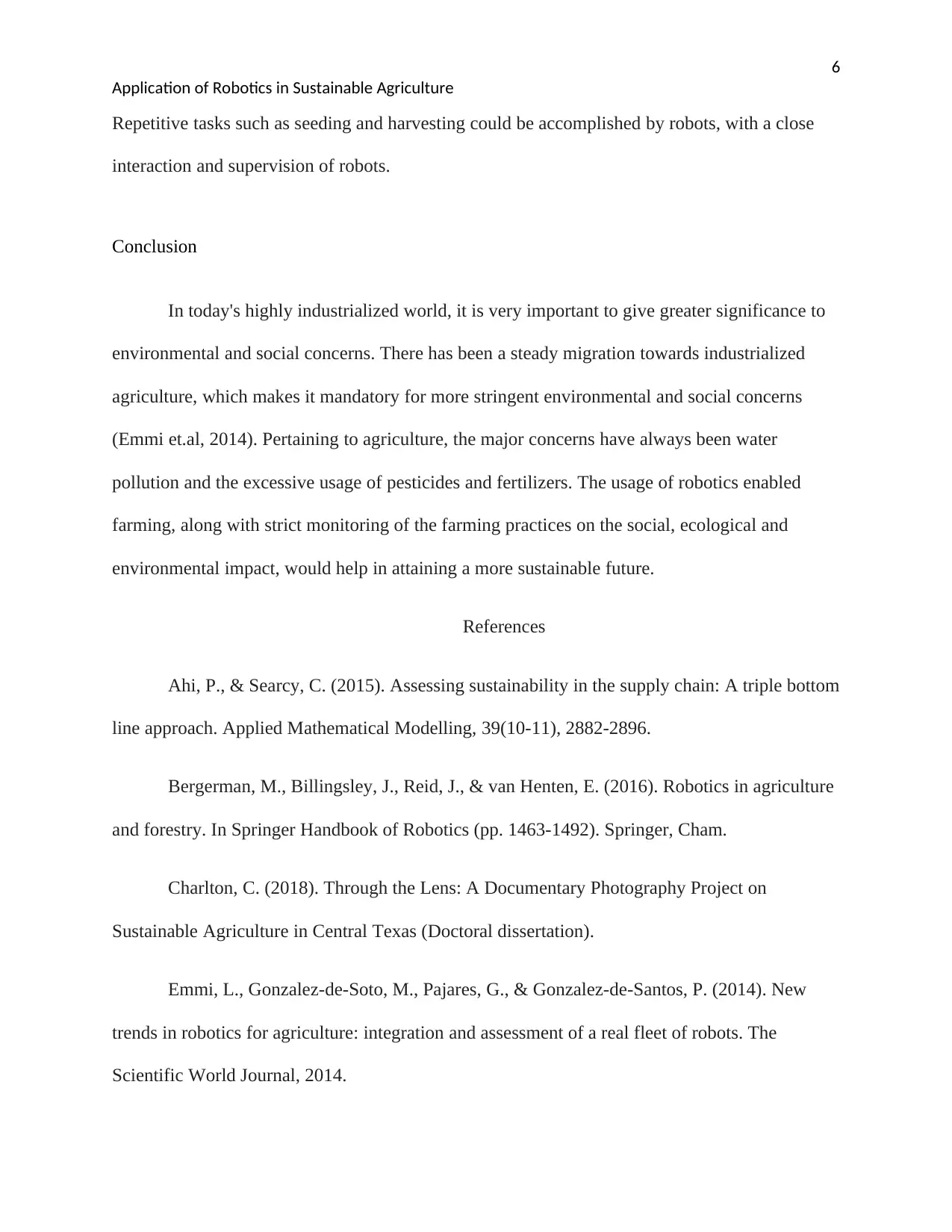
6
Application of Robotics in Sustainable Agriculture
Repetitive tasks such as seeding and harvesting could be accomplished by robots, with a close
interaction and supervision of robots.
Conclusion
In today's highly industrialized world, it is very important to give greater significance to
environmental and social concerns. There has been a steady migration towards industrialized
agriculture, which makes it mandatory for more stringent environmental and social concerns
(Emmi et.al, 2014). Pertaining to agriculture, the major concerns have always been water
pollution and the excessive usage of pesticides and fertilizers. The usage of robotics enabled
farming, along with strict monitoring of the farming practices on the social, ecological and
environmental impact, would help in attaining a more sustainable future.
References
Ahi, P., & Searcy, C. (2015). Assessing sustainability in the supply chain: A triple bottom
line approach. Applied Mathematical Modelling, 39(10-11), 2882-2896.
Bergerman, M., Billingsley, J., Reid, J., & van Henten, E. (2016). Robotics in agriculture
and forestry. In Springer Handbook of Robotics (pp. 1463-1492). Springer, Cham.
Charlton, C. (2018). Through the Lens: A Documentary Photography Project on
Sustainable Agriculture in Central Texas (Doctoral dissertation).
Emmi, L., Gonzalez-de-Soto, M., Pajares, G., & Gonzalez-de-Santos, P. (2014). New
trends in robotics for agriculture: integration and assessment of a real fleet of robots. The
Scientific World Journal, 2014.
Application of Robotics in Sustainable Agriculture
Repetitive tasks such as seeding and harvesting could be accomplished by robots, with a close
interaction and supervision of robots.
Conclusion
In today's highly industrialized world, it is very important to give greater significance to
environmental and social concerns. There has been a steady migration towards industrialized
agriculture, which makes it mandatory for more stringent environmental and social concerns
(Emmi et.al, 2014). Pertaining to agriculture, the major concerns have always been water
pollution and the excessive usage of pesticides and fertilizers. The usage of robotics enabled
farming, along with strict monitoring of the farming practices on the social, ecological and
environmental impact, would help in attaining a more sustainable future.
References
Ahi, P., & Searcy, C. (2015). Assessing sustainability in the supply chain: A triple bottom
line approach. Applied Mathematical Modelling, 39(10-11), 2882-2896.
Bergerman, M., Billingsley, J., Reid, J., & van Henten, E. (2016). Robotics in agriculture
and forestry. In Springer Handbook of Robotics (pp. 1463-1492). Springer, Cham.
Charlton, C. (2018). Through the Lens: A Documentary Photography Project on
Sustainable Agriculture in Central Texas (Doctoral dissertation).
Emmi, L., Gonzalez-de-Soto, M., Pajares, G., & Gonzalez-de-Santos, P. (2014). New
trends in robotics for agriculture: integration and assessment of a real fleet of robots. The
Scientific World Journal, 2014.
⊘ This is a preview!⊘
Do you want full access?
Subscribe today to unlock all pages.

Trusted by 1+ million students worldwide

7
Application of Robotics in Sustainable Agriculture
Feola, G., Lerner, A. M., Jain, M., Montefrio, M. J. F., & Nicholas, K. A. (2015).
Researching farmer behaviour in climate change adaptation and sustainable agriculture: Lessons
learned from five case studies. Journal of Rural Studies, 39, 74-84.
Hammer, J., & Pivo, G. (2017). The triple bottom line and sustainable economic
development theory and practice. Economic Development Quarterly, 31(1), 25-36.
Hunt, J. R., Swan, A. D., Fettell, N. A., Breust, P. D., Menz, I. D., Peoples, M. B., &
Kirkegaard, J. A. (2016). Sheep grazing on crop residues do not reduce crop yields in no-till,
controlled traffic farming systems in an equi-seasonal rainfall environment. Field Crops
Research, 196, 22-32.
Laing, T., Upadhyay, A., Mohan, S., & Subramanian, N. (2017). Environmental
improvement initiatives in the coal mining industry: maximisation of the triple bottom line.
Production Planning and Control.
Wezel, A., Casagrande, M., Celette, F., Vian, J. F., Ferrer, A., & Peigné, J. (2014).
Agroecological practices for sustainable agriculture. A review. Agronomy for sustainable
development, 34(1), 1-20.
Wise, N. (2016). Outlining triple bottom line contexts in urban tourism regeneration.
Cities, 53, 30-34.
Application of Robotics in Sustainable Agriculture
Feola, G., Lerner, A. M., Jain, M., Montefrio, M. J. F., & Nicholas, K. A. (2015).
Researching farmer behaviour in climate change adaptation and sustainable agriculture: Lessons
learned from five case studies. Journal of Rural Studies, 39, 74-84.
Hammer, J., & Pivo, G. (2017). The triple bottom line and sustainable economic
development theory and practice. Economic Development Quarterly, 31(1), 25-36.
Hunt, J. R., Swan, A. D., Fettell, N. A., Breust, P. D., Menz, I. D., Peoples, M. B., &
Kirkegaard, J. A. (2016). Sheep grazing on crop residues do not reduce crop yields in no-till,
controlled traffic farming systems in an equi-seasonal rainfall environment. Field Crops
Research, 196, 22-32.
Laing, T., Upadhyay, A., Mohan, S., & Subramanian, N. (2017). Environmental
improvement initiatives in the coal mining industry: maximisation of the triple bottom line.
Production Planning and Control.
Wezel, A., Casagrande, M., Celette, F., Vian, J. F., Ferrer, A., & Peigné, J. (2014).
Agroecological practices for sustainable agriculture. A review. Agronomy for sustainable
development, 34(1), 1-20.
Wise, N. (2016). Outlining triple bottom line contexts in urban tourism regeneration.
Cities, 53, 30-34.
1 out of 7
Your All-in-One AI-Powered Toolkit for Academic Success.
+13062052269
info@desklib.com
Available 24*7 on WhatsApp / Email
![[object Object]](/_next/static/media/star-bottom.7253800d.svg)
Unlock your academic potential
Copyright © 2020–2025 A2Z Services. All Rights Reserved. Developed and managed by ZUCOL.
